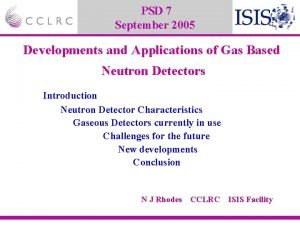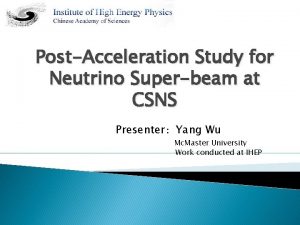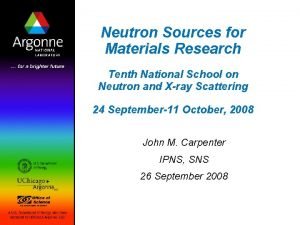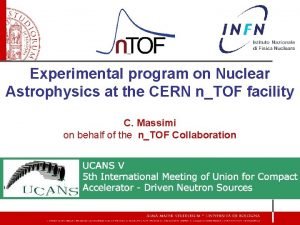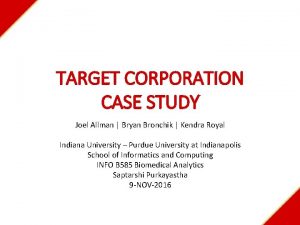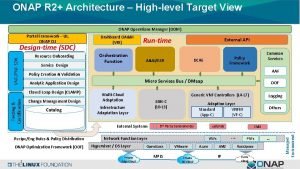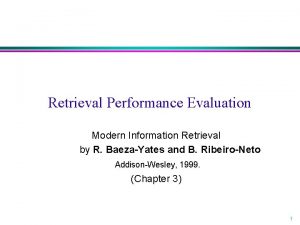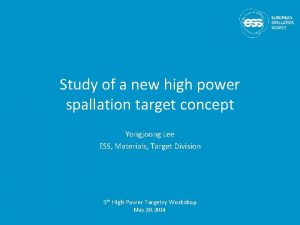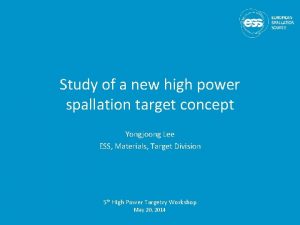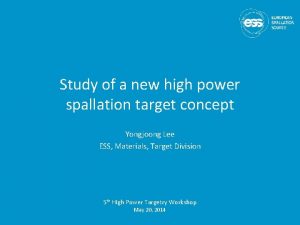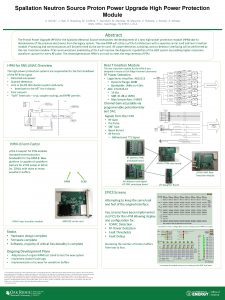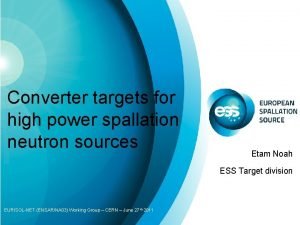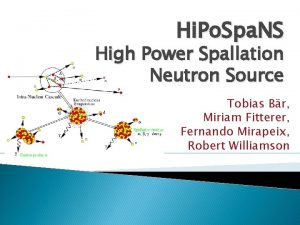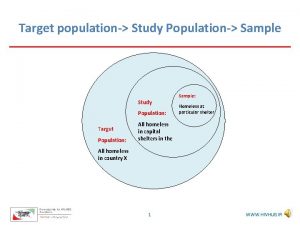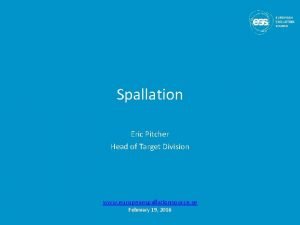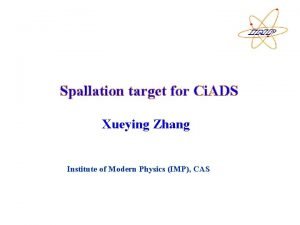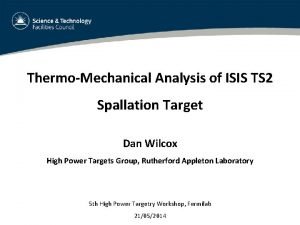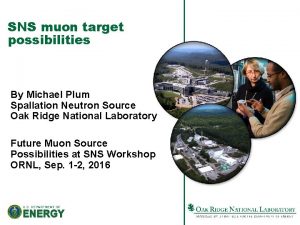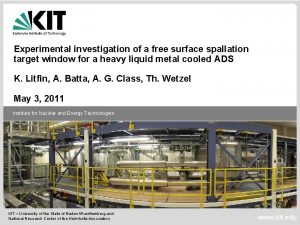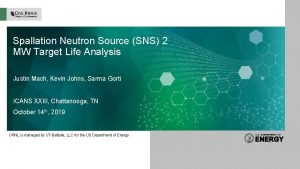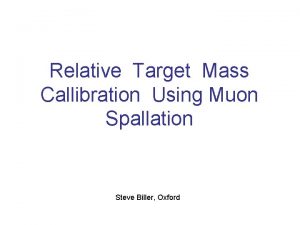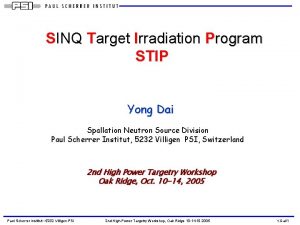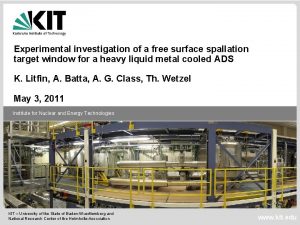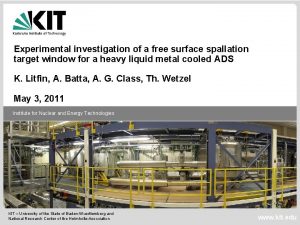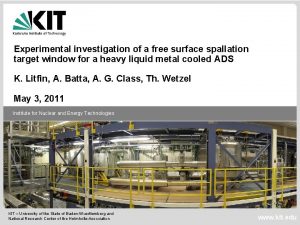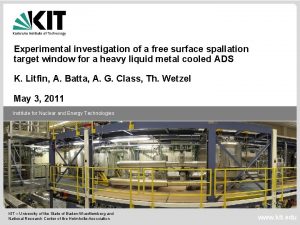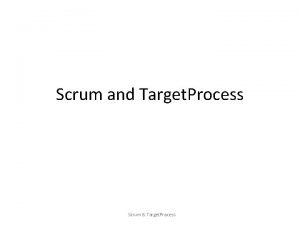Study of a new high power spallation target






















- Slides: 22

Study of a new high power spallation target concept Yongjoong Lee ESS, Materials, Target Division 5 th High Power Targetry Workshop May 20, 2014

Spallation Target at ESS • 5 MW spallation source – 5 MW (2. 0 Ge. V/2. 5 m. A) proton beam – 2. 86 ms long beam pulse with 14 Hz repetition rate • Rotating tungsten target: – Helium cooled target with water cooled backup 2

Motivation • Looking for a target concept that is based on simple design, with small number of standard type tungsten blocks in large dimensions. • Looking for a target concept that is based on simple cooling flow patterns such that CFD simulations have better predictability. • Demonstration of technical feasibility of a new target concept that is readily adaptable both for helium cooled and water cooled options.

Target configuration used for this study • Five 40 cm long horizontal tungsten slabs with equal thickness 16 mm. 4

Beam power deposition • TDR Baseline (2013): – 5 MW (2. 5 Ge. V/2. 0 m. A) double Gaussian beam with peak current density 53 u. A/cm 2 Target volume Deposited power [k. W] Target I 820 Target II 1374 Target III 594 Total 2788 5

Flow analysis • Helium cooled option – 3 kg/s mass flow rate – 3 bar operation pressure – Total 363 tungsten slabs • Water cooled option – 99 kg/s mass flow rate – 6 bar operation pressure – Total 264 tungsten slabs 6

CFD: Transient helium flow analysis Helium Cooled Target Volume Max Temperature Pre-pulse Max Temperature Post-pulse Temperature Amplitude Target I 728. 5 K 813. 9 K 85. 4 K Target II 736. 0 K 818. 8 K 82. 8 K Target III 432. 8 K 450. 9 K 18. 1 K Pressure Drop 97. 0 k. Pa: Surface and time averaged 7

CFD: Transient water flow analysis Water Cooled Target Volume Max Temperature Pre-pulse Max Temp: Postpulse (Bulk/Surface) Temperature Amplitude Target I 326. 1 K 429. 7 K/393. 6 K 103. 6 K Target II 334. 3 K 428. 9 K/402. 3 K 94. 6 K Target III 310. 0 K 329. 4 K/324. 8 K 19. 4 K Pressure Drop 35. 3 k. Pa: Surface and time averaged 8

Stress analysis: Helium cooled target Helium Cooled Target Volume Max Principal Stress Pre-pulse Post-pulse Stress Amplitude Target I 168 MPa 194 MPa 26 MPa Target II 116 MPa 152 MPa 36 MPa 9

Stress analysis: Water cooled target Water Cooled Target Volume Max Principal Stress Pre-pulse Post-pulse Stress Amplitude Target I 23 MPa 113 MPa 90 MPa Target II 26 MPa 115 MPa 89 MPa 10

Decay heat analysis • Irradiation history: 5 years operation with 5000 hours per year beam on target at 5 MW • Benchmark (MCNPX): 41. 5 k. W in bare W at time zero Dose rate calculated by FLUKA in k. W Cooling time [s] 0 3600 7200 14400 28800 86400 He-cooled Naked W 32. 7 20. 0 18. 6 16. 9 14. 7 9. 9 He-cooled 0. 5 mm Ta-clad W 39. 3 25. 9 24. 3 22. 7 20. 7 16. 1 H 2 O-cooled 0. 5 mm Ta-clad W 42. 9 29. 4 27. 9 26. 2 24. 2 19. 6 D 2 O-cooled 0. 5 mm Ta-clad W 39. 9 26. 6 25. 0 23. 4 21. 4 16. 8 11

Decay heat analysis: Thermal equilibrium • Assumptions: • Normalization factor in decay heat to make it total 47 k. W • Loss of coolant in the target and the monolith, with air ingression • Simple tungsten disc surrounded by monolith shielding blocks with 2 cm air gap between them. 12

Decay heat analysis: Temperatures at thermal equilibrium Coolant Decay Heat at time zero Decay heat at thermal equilibrium Time to reach thermal equilibrium Max. temperature at thermal equilibrium Helium 47 k. W 37 k. W 40 min 912 K Water 62 k. W 38 k. W 270 min 928 K 13

Exothermic heat analysis • Tungsten and tantalum oxidation: exothermic process – W + O 2 -> WO 2, d. H = -589. 7 k. J/W-mol – W + 1. 5*O 2 -> WO 3, d. H = -842. 9 k. J/W-mol – Ta + 1. 25*O 2 -> 0. 5*Ta 2 O 5, d. H = -1023. 0 k. J/W-mol • Literature survey on tungsten and tantalum oxidation in air led to the estimation that the exothermic heat generated on the target surface will reach 10 k. W at 800 C. 14

Thermomechanical properties under flat proton beam profile • New accelerator baseline at ESS: • Rastered beam scanning a rectangular surface on beam window: dx = 140 mm, dy = 32 mm • Beam parameters changed from 2. 5 Ge. V/2. 0 m. A to 2. 0 Ge. V/2. 5 m. A, giving the peak current density on target 55. 8 u. A/cm 2 15

Evolution of target configuration – V 2 • Minimizing tungsten volume: – No visible neutronic penalty by reducing the W slab length from 40 cm to 30 cm and the W slab total thickness from 80 mm to 70 mm – Reduced W slab size reduces decay heat in W by more than 10 %. – Optimizing temperature and stress configurations in W volume. – No through going proton beam shall be allowed! 16

CFD: Transient flow analysis – V 2 Helium Cooled Target: 3 kg/s @ 6 bar Target Volume Max Temperature Pre-pulse Max Temperature Post-pulse Temperature Amplitude Target I 697. 30 753. 47 56. 17 Target II 714. 59 800. 82 86. 23 Pressure Drop 49 k. Pa: Surface and time averaged Water Cooled Target: 99 kg/s @ 6 bar Target Volume Max Temperature Pre-pulse Max Temp: Postpulse Temperature Amplitude Target I 320. 11 K 411. 76 K 91. 65 K Target II 320. 31 K 417. 21 K 96. 90 K Pressure Drop 34 k. Pa: Surface and time averaged 17

Stress analysis: Helium and water cooled targets –V 2 Helium Cooled Target Volume Max von-Mises Stress Pre-pulse Max von-Mises Stress Post-pulse Stress Amplitude Target I 99 MPa 93 MPa -6 Mpa (30 Mpa) Target II 68 MPa 125 MPa 57 Mpa (60 Mpa) Water Cooled Target Volume Max von-Mises Stress Pre-pulse Max von-Mises Stress Post-pulse Stress Amplitude Target I 10 MPa 70 MPa 60 MPa Target II 12 MPa 104 MPa 92 MPa 18

Thermal and mechanical analysis: Beam entrance window • Each of the 33 sectors could be considered as an 150 k. W spallation target. Maximum Temperatures in Beam Window Pre-pulse Post-pulse Temp. Amplitude Helium Cooled Target 457. 87 K 485. 71 K 27. 84 K Water Cooled Target 321. 63 K 351. 49 K 29. 86 K Maximum Stresses in Beam Window Pre-pulse Post-pulse Stress Amplitude Helium Cooled Target 210 MPa 280 MPa 70 MPa Water Cooled Target 123 MPa 153 MPa 30 MPa 19

Conclusions • The feasibility of the target concept based on sectorized horizontal slabs is demonstrated, both for helium cooled and water cooled options at 5 MW proton beam power. Coolant Number of W Max. Post-pulse slabs temp. tensile stress Max. temp. at LOCA Helium 3 kg/s @ 6 bar 495 bare W blocks 801 K (528 C) 125 MPa < 639 C Water 99 kg/s @ 6 bar 495 Ta clad W blocks 417 K (144 C) 104 MPa < 655 C • The exothermic heat generated from the oxidation of tungsten and tantalum could reach 10 k. W at high temperatures above 700 C. • There are relatively small number of tungsten blocks in three standardized shapes. • The post pulse peak equivalent stress in the beam window is below 300 MPa both for helium cooled and water cooled options. 20

Outlook • Next steps: – – – Thermal and mechanical optimization Target vessel optimization Analysis of non-axisymmetric flux distribution Analysis of dynamic effects of the beam rastering Down to earth engineering and prototyping • Special thanks to Eric Pitcher, Per Nilsson and Thomas Mc. Manamy 21

Open discussions Thank you for your comments and feedback! 22
 Spallation neutron source
Spallation neutron source Spallation neutron source
Spallation neutron source Spallation neutron source
Spallation neutron source Cristian massimi unibo
Cristian massimi unibo Primary target market and secondary target market
Primary target market and secondary target market Real power and reactive power
Real power and reactive power Target corporation case study
Target corporation case study High level target
High level target Bmsb treatment providers
Bmsb treatment providers Case series
Case series Retrospective cohort study vs prospective cohort study
Retrospective cohort study vs prospective cohort study Process of method study
Process of method study Marty lobdell study less study smart
Marty lobdell study less study smart Study to study
Study to study Distinguish between motion study and time study
Distinguish between motion study and time study Time and motion study example ppt
Time and motion study example ppt High school transcript study
High school transcript study High precision vs high recall
High precision vs high recall High precision vs high recall
High precision vs high recall Directive supportive leadership
Directive supportive leadership High expectations high support
High expectations high support High precision vs high accuracy
High precision vs high accuracy High directive and high supportive behavior
High directive and high supportive behavior
